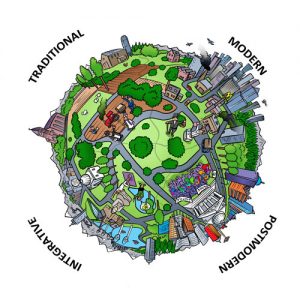The Connection between Integral and Metamodern Thinking and Spirituality
The concept of worldview is pretty central to my work, and there are different ways of categorizing worldviews. I want to add some depth to a post I wrote last year, which I began by restating a summary of Annick de Witt’s model for categorization, which involves a world cartoon graphic that shows some common cultural aspects of the 4 main worldview categories. This categorization is similar to the spiral dynamics model and related models that a lot of metamodern and integral theory work is based upon, but de Witt’s system doesn’t present any of these as stages and no category appears as being above or below any other. They are simply presented as different ways in which you can be oriented within the same world. All people and all worldviews simply coexist within this model.

I analyzed her graphic and I envisioned it overlaid within a rectangular coordinate system:

In my interpretation, the X axis represents the spiritual/secular dichotomy. We can say that “spiritual” means the interconnection to the timeless and to the underlying reality behind appearances that holds it all together and gives enduring meaning. “Secular” quite simply refers to things that are instead more worldly focused, with the assumption that everything in reality is temporal and belongs to an age. So this axis ultimately hinges upon the belief that there is something timeless holding reality together and that is what provides ultimate meaning for our lives.
The Y axis represents the epistemically monistic/pluralistic dichotomy. This dichotomy hinges on how complex or straightforward it is to understand reality. The epistemically monistic worldviews are also reductive, since they have a privileged source of knowledge. Whether this source is modern science or a holy book, the common thread is that all other sources need to ultimately be interpreted in terms of this privileged source in order to be considered valid. Epistemically pluralistic is also multi-perspectival, since more than one perspective on reality can simultaneously be considered valid. However, unlike the postmodern, which lacks a process for determining a greater whole in which the perspectives can be contexualized, the integrative worldview category provides a way that we might reach this, and this is because it is both multi-perspectival and spiritual. It is the non-dogmatic spirituality that allows us to consider multiple perspectives and to seek the deeper reality that ties it together, and it is through our search for meaning in life that we might find this.
Note that the “integrative” within this model seems to correspond to the “Tier 2” stages in Ken Wilber’s AQAL model and it also seems to align with the “yellow” or “teal” or “integral” stage that Hanzi Freinacht sees as what we should aim for in our personal and societal development. Now, I will admit that I do largely agree with Hanzi and I also find a lot of agreement with Wilber. They all seem to agree that there are stages of development that transcend and include the prior stages and that, therefore, what de Witt’s model calls “integrative” should be above and beyond the other 3, as far as development goes. The sensibilities and perspectives of the other 3 (traditional, modern, postmodern) are transcended and included within the integrative, or whatever word we wish to use for that stage. Despite this, I like the way Annick frames it because it is less condescending to convey to people who are at the lower levels. Her model simply shows these as different co-equal perspectives on the world and none are necessarily better than others. In her work, she does go on to carefully convey that there are benefits of some sort of integrative worldview, but the beauty of framing it initially this way is that it is more inviting to people who are traditional, modern, or postmodern. So while I agree that we should try to develop to an integral stage as individuals, as communities, as nations, and as a global society, I also acknowledge the utility of presenting the virtues of integral and metamodern thinking to people without coming off as condescending.







